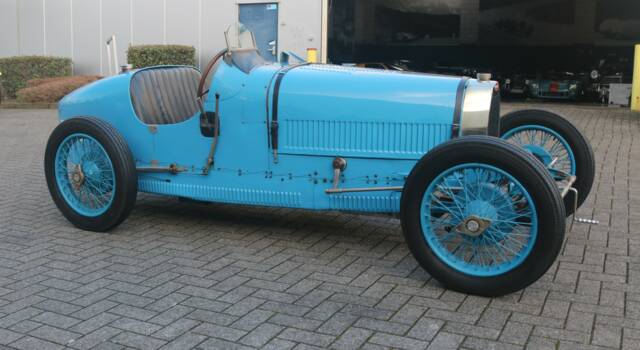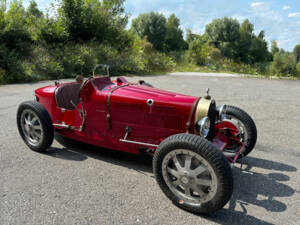Bugatti Type 35 classic cars for sale
The Bugatti Type 35 sets standards as a milestone in motorsport: built between 1924 and 1930, this open two-seater from Molsheim is famed for its lightweight construction, distinctive eight-cylinder engine and unfiltered driving experience. Today, it remains one of the most recognisable racing cars of all time.
Suchergebnisse

1927 | Bugatti Type 35 A
Bugatti 35 A K. Betti Replica

1932 | Bugatti Type 35 B
Mit Schweizer Strassenzulassung
VAT is reclaimable
History and Introduction of the Bugatti Type 35
The Bugatti Type 35 stands as a touchstone in racing car construction, engineered at the Molsheim factory from 1924 to 1930. Ettore Bugatti's background blended Italian artistry with French technical ingenuity, resulting in a car designed from the outset for both private clients and the factory works team. The Type 35 debuted in 1924 at the Lyon Grand Prix and from the start, was available as a ready-to-race machine for discerning buyers. A defining aspect of its legacy is its sheer racing dominance: the Type 35 amassed over 2,000 victories in period and brought Bugatti global recognition. Its influence can be traced far beyond motorsport, shaping the design and engineering direction for contemporary sports cars.
Model History
The Type 35's engineering roots lie in Bugatti's earlier Type 30 series, the first Bugatti model produced with an eight-cylinder engine, paving the way for the racing legend. The original Type 35 featured an inline-eight engine with overhead camshafts and was notable for its five-bearing crankshaft and roller-bearing connecting rods. Variations quickly followed: the Type 35C introduced a Roots supercharger, the 35T was created for the Targa Florio with a larger 2.3-litre engine, and the Type 35B combined a 2.3-litre engine with a supercharger for maximum performance. The Type 35A was a more affordable, slightly detuned road-going version, while the pure racing versions were instantly recognisable by their cast alloy wheels and distinctive aluminium bodies. Production of the various Type 35 variants totalled over 300 units.
Highlights of the Bugatti Type 35
The Bugatti Type 35 was conceived for motorsports and set new standards for versatility: a road-legal car equally at home on racing circuits. It gained notoriety for technical novelties such as its alloy wheels, which dramatically reduced unsprung mass, and its signature straight-eight, three-valve engine. The car could accelerate to competitive speeds thanks to its light weight (approx. 750 kg) and precise four-speed manual transmission. The Type 35 was admired for its precise handling, reliability under stress, and a design that was as functional as it was visually striking. The car’s iconic blue livery—'Bugatti Blue'—became synonymous with French motorsport.
In the context of current market activity, the Bugatti Type 35 dominates both supply and demand on the Classic Trader platform: 100% of Bugatti vehicles listed belong to this series. Likewise, all listing views for the marque are for the Type 35. This underlines its singular status among Bugatti models and its high visibility among enthusiasts.
Technical Data
Special Editions and Collectible Models
Several distinct versions of the Type 35 were produced, each tailored for specific competition needs:
- Type 35A ('Tecla'): An entry-level variant with a less powerful engine and wire wheels, primarily for road use.
- Type 35C: Featured a Roots supercharger for increased performance, successfully used in Grand Prix racing (notably winning French Grands Prix in 1928 and 1930).
- Type 35T: Built for the Targa Florio race, sporting a larger 2.3-litre naturally aspirated engine.
- Type 35B: Final and most potent variant with a 2.3-litre supercharged engine, outputting up to 138 PS.
With just over 300 original examples produced and numerous replicas built to exacting standards later, each original Type 35 commands significant attention among connoisseurs.
Weak Spots and Common Issues
Due to the advanced age and racing pedigree of original Type 35s, mechanical wear is common, especially on the engine internals (crankshaft bearings, connecting rods), the supercharger on C and B variants, gearbox synchronisation, and alloy wheels. Corrosion on the aluminium body and chassis, as well as wear on the cable-operated braking system, are other areas to inspect. Many replicas or restorations may incorporate non-original mechanicals (e.g. engines from VW or Triumph). Buyers seeking authenticity should scrutinise chassis numbers, provenance, and verify technical originality.
Engine, Performance, Transmission and Handling
The heart of the Type 35 is its straight-eight engine, equipped with overhead camshafts and, in higher performance models, Roots-type superchargers. Early models produced 90 PS, while the supercharged 35B achieved up to 138 PS. Despite these figures, the car's light weight enabled rapid acceleration and excellent agility. The manual four-speed transmission offers precise gear changes. Suspension utilises solid axles with leaf springs, a configuration tuned for race tracks and robust enough for all-day endurance events. Rear-wheel drive transmits power confidently, while the alloy wheels reduce rotational mass, allowing for quick direction changes—essential in period road racing.
Popular variants:
- Type 35: Inline-eight, 90 PS, 1,991 cc, four-speed, approx. 750 kg
- Type 35B: Supercharged inline-eight, 2,262 cc, up to 138 PS
- Type 35C: Supercharged, 1,991 cc, approx. 128 PS
- Type 35T: Enlarged 2,262 cc engine, 100 PS, built for the Targa Florio undefined
Interior, Comfort, Exterior and Design
The Type 35's form follows performance: a strict two-seater open body, almost always in lightweight aluminium. The narrow, streamlined nose, signature horseshoe grille, and prominent external cylinder head studs give the car its unmistakable look. Alloy spoke or wire wheels are paired with distinctive tyre profiles, while the body is most frequently finished in 'Bugatti Blue,' the French national racing colour. The interior combines period-correct materials: exposed aluminium on the dashboard, classic mechanical instruments, and indispensable accessories like leather caps and goggles for the driver. Options included leather upholstery and, in very rare cases, tailored details for private customers or special racing entries.
Other Relevant Features
The Type 35 became a blueprint for the ideal private racing car: usable both on public roads and race circuits. Numerous high-quality replicas exist, some fitted with more modern mechanicals (VW, Triumph engines) but visually faithful to the original. The car remains road-registerable, making it eligible for vintage rallies and classic car events. The largest Bugatti museum, the Schlumpf Collection in Alsace, showcases an unparalleled array of original examples for comparison and study.
Summary
The Bugatti Type 35 distinguishes itself as the defining sports and racing car of the interwar period. It combines innovative engineering, elegant design, and a motor racing record unmatched at the time. With its dominance both in historic competition and today’s collectors’ market, the Type 35 sets the bar for what a pre-war grand prix car can be, making every encounter with an original or replica a unique event in motoring history.

